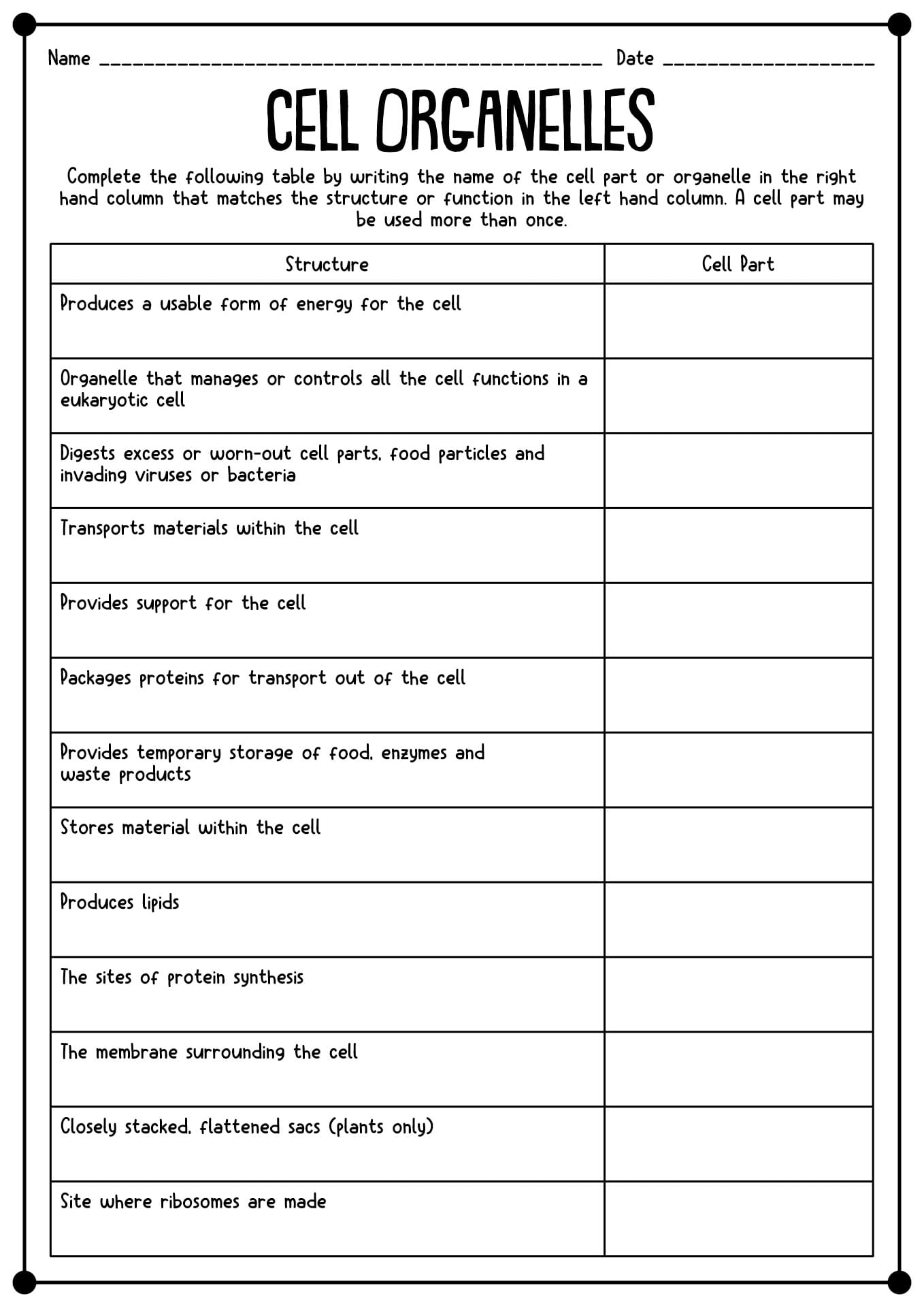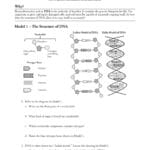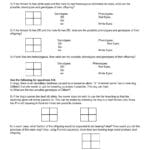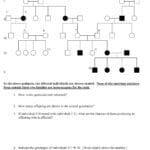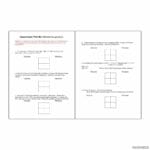Unlocking the Secrets of Cells: Why Cell Organelles Worksheets Are Key
Ready to explore the fascinating world of cells? Cell organelles worksheets are your ultimate guide! They break down complex biology into manageable chunks, making it easier to understand how these tiny powerhouses work.
Why Worksheets Rock:
- Active Learning: Labeling, filling blanks, and matching activities make learning stick.
- Memory Boost: Repetition helps solidify information in your brain.
- Laser Focus: Worksheets hone in on key concepts for deeper understanding.
- Progress Check: Think of them as mini-quizzes to track your learning journey.
- Learning Your Way: From visual learners to hands-on explorers, there’s a worksheet style for everyone.
Exploring the Cell’s Toolbox: Types of Cell Organelles Worksheets
Just like a toolbox has different tools for different tasks, there are various types of cell organelles worksheets:
- Identification: Label organelles on a cell diagram to reinforce visual recognition.
- Function: Describe the role of each organelle, understanding its unique job.
- Matching: Connect organelles to their functions or descriptions, boosting recall and association.
- Fill-in-the-Blank: Complete sentences with organelle names or functions, testing vocabulary and concepts.
- Diagraming: Draw or complete diagrams, developing visual representation and spatial understanding.
- Comparison: Analyze the similarities and differences between organelles or cells, encouraging critical thinking.
Finding Your Perfect Match: Choosing the Right Worksheet
- Grade Level: Match the worksheet to your current learning level.
- Content Check: Ensure it covers the material you need to know.
- Variety is Key: Experiment with different types of worksheets to find your best fit.
- Answer Keys Matter: Check your work and identify areas for review.
- Visuals Are Your Friend: Diagrams and images can significantly enhance understanding.
Unearthing Hidden Gems: Where to Find High-Quality Cell Organelles Worksheets
Ready to find top-notch worksheets? The internet is a treasure trove!
Online Sources:
- Search Engines: Use keywords like “cell organelles worksheets,” “biology worksheets,” and specific organelle names.
- Educational Websites: Explore sites like Education.com, Worksheetworks.com, and Khan Academy for free printable worksheets.
- Publisher Websites: Check out resources from educational publishers like McGraw-Hill, Pearson, and Cengage.
Print Resources:
- Workbooks: Look for comprehensive biology workbooks at bookstores or online retailers.
- Textbook Supplements: Check if your textbook offers accompanying workbooks or online resources.
Evaluation is Key:
- Preview Before You Print: Ensure the material is accurate, up-to-date, and age-appropriate.
- Read Reviews: See what other educators are saying about specific resources.
Beyond Filling in the Blanks: How to Use Cell Organelles Worksheets Effectively
Cell organelles worksheets are more than just exercises—they’re springboards for deeper learning:
Effective Strategies:
- Pre-Assessment: Start with a quick quiz using worksheet questions to gauge prior knowledge.
- Active Learning: Incorporate hands-on activities like building cell models or acting out organelle functions.
- Collaborative Work: Encourage group work, discussions, and peer teaching.
- Technology Integration: Supplement worksheets with virtual cell simulations, interactive diagrams, and engaging videos.
- Differentiation: Adapt worksheets to meet individual learning styles and needs. Offer word banks, simplified diagrams, or extended time.
Bonus Tips:
- Clear Instructions: Provide specific and concise instructions to guide student work.
- Color Coding: Encourage students to use color to differentiate organelles on diagrams.
- Sharing and Discussion: Create opportunities for students to share their completed worksheets and discuss their findings.
- Further Exploration: Use worksheets as a launching pad for research projects, presentations, or class debates.
Catering to Every Mind: Are There Cell Organelles Worksheets for Different Learning Styles?
Absolutely! Just like cells have diverse organelles, learners have unique styles:
- Visual Learners: Thrive on diagrams, 3D models, videos, and colorful visuals.
- Auditory Learners: Learn best through lectures, discussions, podcasts, and even songs or rhymes.
- Kinesthetic Learners: Grasp concepts through hands-on activities, movement, and building models.
- Reading/Writing Learners: Excel with written descriptions, research projects, and creating their own explanations.
- Logical/Mathematical Learners: Enjoy puzzles, data analysis, graphs, and designing experiments.
The key is to provide a variety of activities and resources to engage all types of learners!
Journey Beyond the Worksheet: Other Resources to Enhance Learning
Worksheets are just the beginning! Dive deeper into the cellular world with:
- Interactive Simulations: Explore virtual cells, manipulate organelles, and experiment with different scenarios.
- 3D Models: Construct cells using clay, pipe cleaners, or even candy to visualize structure and spatial relationships.
- Analogies: Connect abstract concepts with relatable real-world examples (e.g., the cell as a factory or city).
- Microscope Observations: Experience the awe of seeing real cells firsthand and observing organelles in their natural environment.
- Real-World Applications: Explore the relevance of cell biology in fields like medicine, genetics, and biotechnology.
Remember: Science is ever-evolving! What we understand about cells today will continue to grow and change. Embrace curiosity, ask questions, and keep exploring the incredible world within!
- Unlock Water’s Symbolism: A Cross-Cultural Exploration - April 20, 2025
- Identify Black and White Snakes: Venomous or Harmless? - April 20, 2025
- Unlocking Potential: Origins High School’s NYC Story - April 20, 2025
